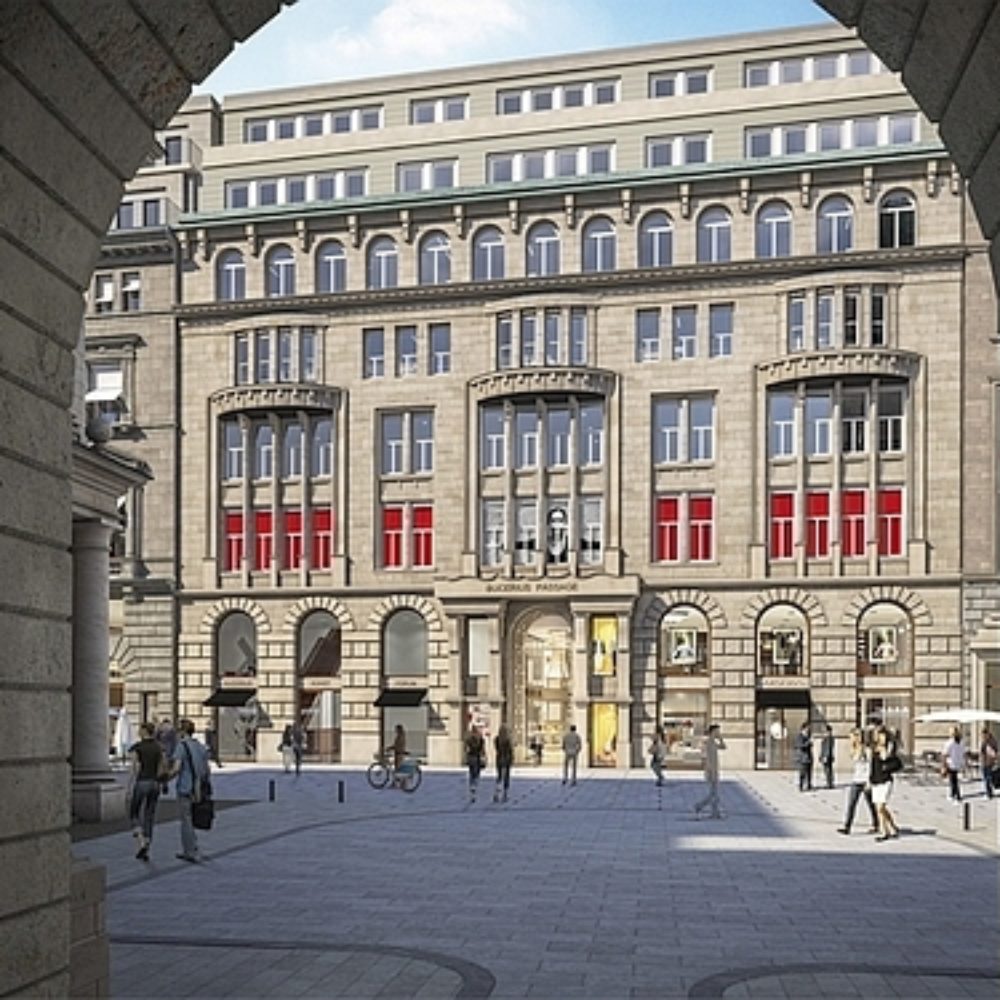Swim City, eine ehemalige Ausstellung des S AM in Basel, kommt nach Berlin. Die Leihgabe präsentiert internationale Flussbadprojekte und eine Filminstallation von Jürg Egli im DAZ. Das Architekturzentrum ist ein würdiger neuer Standort, denn auch Berlin besaß seine Flussbäder. Die letzten von ihnen wurden vor 95 Jahren geschlossen. Höchste Zeit für die deutsche Metropole, eine der faszinierendsten urbanen Aktivitäten wiederzubeleben.
12. Juni 2020 | Özlem Özdemir
S
wim City fasst ein Phänomen zusammen, das in mehreren Städten auf der ganzen Welt ins Rollen kommt. Von manchen nur als ein erheiterndes Kuriosum oder exotisches Treiben gesehen, ist es in der Schweiz seit den 90 iger Jahren Teil der städtischen Tradition. Bekannt ist etwa das Aareschwimmen in Bern oder auch das Rheinschwimmen in Basel. Mit einem Sprung ins Wasser, ausgerüstet mit einer Tasche namens „Wickelfisch“ (dem Büroangestellte sogar ihre Laptops anvertrauen) steckt man mitten in den Lebensadern der Stadt. Hier lässt man sich wie selbstverständlich vom Fluss dahintreiben. Er bietet Erfrischung, oftmals eine eiskalte. Oder er fungiert als öffentliches Verkehrsmittel, das einen zum Arbeitsplatz befördert.
Basel war also prädestiniert zum ersten Ausstellungsort von Swim City zu werden. Barbara Buser, Leiterin des schweizerischen baubüro in situ, kuratierte die Ausstellung. Andreas Ruby, Museumsdirektor des Schweizerischen Architekturmuseums S AM und Yuma Shinohara gehörten zum Kuratorenteam. Future Architecture Platform (ein Verbund europäischer Architekturinstitutionen, der innovative Positionen in Architektur und Städtebau fördert) wirkte mit bei der Präsentation von internationalen Flussbadprojekten. Zur Auswahl gehören: Ilit Vert (Paris), Pool is Cool (Brüssel), Thames Baths (London), +Pool (New York) und Charles River Swimming Initiative (Boston). Ferner informiert die Ausstellung über die historische Entwicklung in den verschiedenen Städten. Kurzum: Die BesucherInnen schnuppern die Luft des Flussschwimmens.


Besonders spannend ist der Beitrag von Jürg Egli. Seine im und unter Wasser treibende Kamera bewegt sich entlang der Stadtarchitektur und den baumbestandenen Ufern. Sie gleitet unter Brückenkonstruktionen und an Schwimmern vorbei. Plätschern, Zurufe, Gesprächsfetzen, Lachen, das Rauschen des Wassers und andere Laute von Mensch und Natur begleiten die Filmfragmente durch die urbane Landschaft.
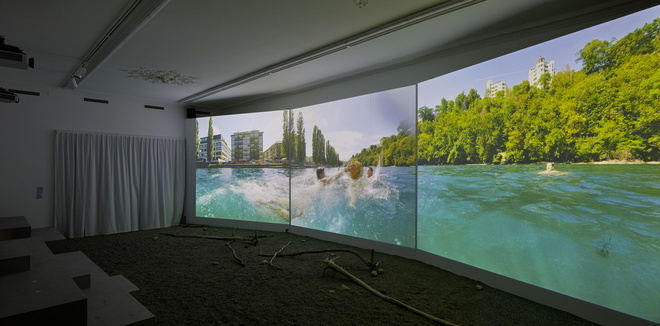
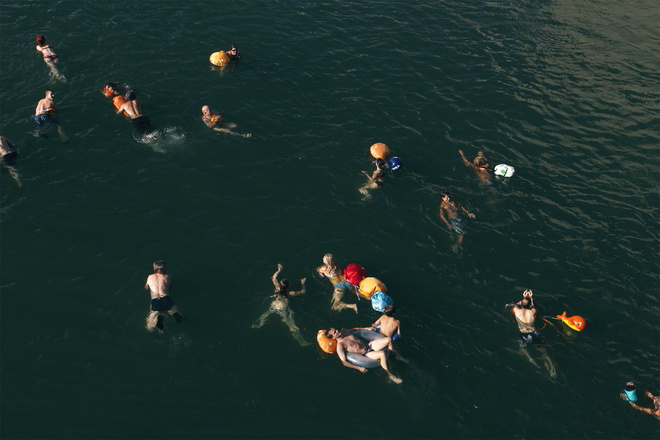
Eigentlich wäre es erstaunlich einfach, all das auch selbst zu erleben. Es ist naheliegend und natürlich: Man braucht nur hineinzuspringen. Und doch bleiben die Schweizer Städte die Pioniere dieser Bewegung.
Schauen wir nach Berlin. Um 1900 konnte man wie selbstverständlich in der Spree baden. Außerdem wurde 1919 ein Schwimmwettbewerb auf dem Neuköllner Schifffahrtskanal ausgetragen. Er hatte 117 Teilnehmer und 50.000 Zuschauer. Die heutige Wasserqualität lässt solche spektakulären Veranstaltungen in der Hauptstadt nicht zu – könnte man meinen. Doch Initiativen wie das Flussbad Berlin wollen sie wieder möglich machen. Und die Zukunft sieht vielversprechend aus. Das Flussbad im Spreekanal ist Teil der Koalitionsvereinbarung der Landesregierung. Es ist ein erklärtes städtebauliches Ziel.
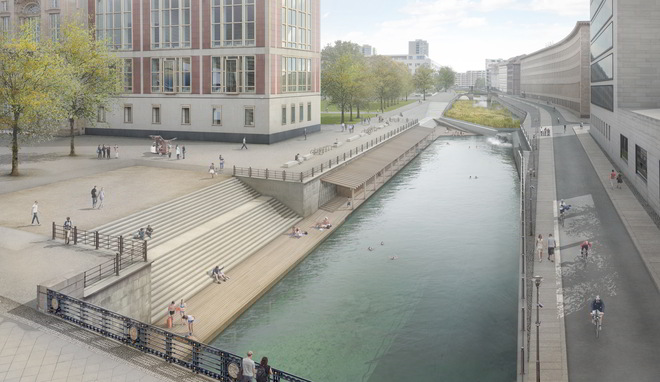
Der Berliner Flussbad Pokal ist eine weitere Errungenschaft der Initiative. Dieser Schwimmwettbewerb vor der historischen Kulisse der Innenstadt wird seit 2015 ausgetragen. Und: Das sportliche (Ausnahme-)Ereignis hat sogar einige ästhetische Nebeneffekte. Die halbnackt schwimmenden Berlinerinnen und Berliner wirken vor der ehrwürdigen Kulisse der geschichtsträchtigen Gebäude erfrischend lässig. Städtisches Flussschwimmen bietet einen sichtlich inspirierenden Kontrast. Es besteht ein reizvoller Gegensatz zwischen der soliden Würde der steinernen Stadt und dem fließenden Wasser mit den schwimmenden Menschen. (Wohlgemerkt: Es ist anders als Joggen im Stadtpark.) Das Interessante am urbanen Schwimmen ist die Gegenüberstellung von Architektur und Körperhaltung der Menschen. Erstere ist vertikal und zweitere horizontal. Und es sind vor allem die ins Wasser stürzenden Fassaden, die einen besonderen Effekt bieten. Beispiel: Die sonst unberührbare Außenwand des Bode-Museums entpuppt sich als durchaus nahbar. Der Fluss erweist sich, nicht zuletzt, als eine demokratisierende Gelegenheit. Er trägt alle Menschen der Stadt und bringt sie voran. Er wird zu einer organischen Erweiterung des öffentlichen Raumes.
Ende 2019 kam der Berliner Senat zu einem erfreulichen Entschluss. Am Humboldt-Forum soll eine Freitreppe zum künftigen Flussbad Berlin führen. Und weitere sind noch in Planung. Nun müssen sich nur noch die ökologischen Bedingungen erfüllen. Dann steht der Eröffnung im Jahr 2025 nichts mehr im Wege. Die Zeichen stehen gut für ein aufregendes Kultgeschehen in nicht allzuweiter Ferne. Die Ausstellung Swim City im DAZ gibt einen Vorgeschmack und macht Lust darauf, schon jetzt einzutauchen. Und die Besucherinnen und Besucher sollten nicht vergessen: Die Spree liegt gleich nebenan. ♦
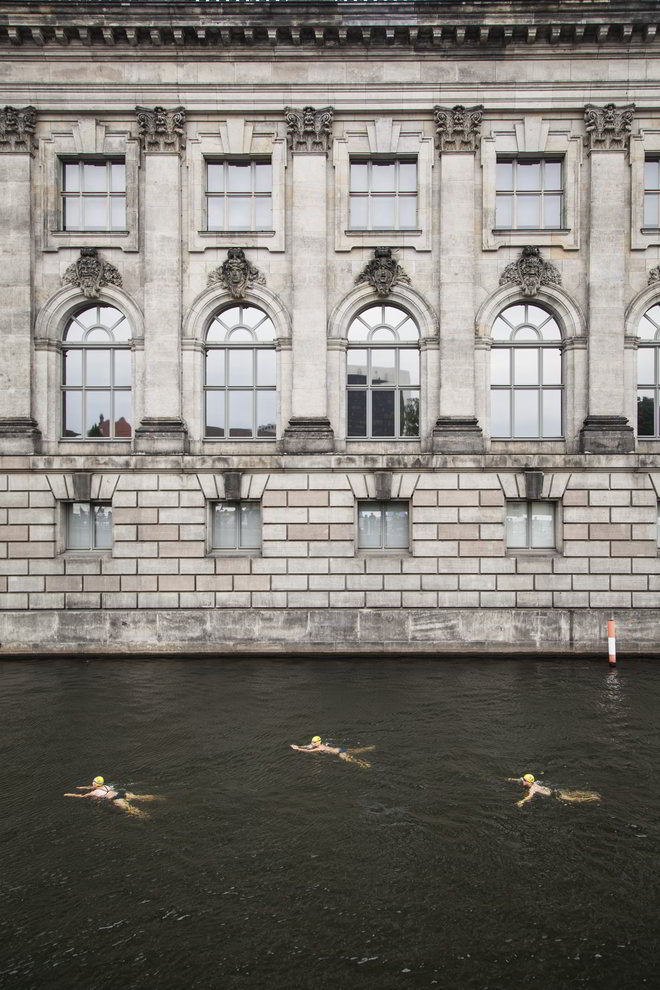
Zur Website von SWIM CITY im DAZ Berlin
Swim City: River Swimming in Urban Space, 20.6.2020-2.8.2020, DAZ Berlin
Swim City, a former S AM exhibition in Basel, is coming to Berlin. The loan presents international river bath projects and a film installation by Jürg Egli at the DAZ. The Architekturzentrum is a worthy new venue, as even Berlin had its river baths. The last of them were closed 95 years ago. High time for the German metropolis to revive one of the most fascinating urban activities.
Swim City sums up a phenomenon that is taking place in several cities around the world. Seen by some only as an exhilarating curiosity or exotic activity, it has been part of the urban tradition in Switzerland since the 1990s. Well-known examples are the Aare Swimming in Berne or the Rhine Swimming in Basel. By jumping into the water, equipped with a bag called „Wickelfisch“ (to which office workers even entrust their laptops), you are in the middle of the city’s lifelines. Here you let yourself be carried away by the river as if it were a matter of course. It offers refreshment, often an icy cold one. Or it functions as public transport that takes you to your workplace.
Basel was thus predestined to become the first exhibition location of Swim City. Barbara Buser, head of the swiss baubüro in situ, curated the exhibition. Andreas Ruby, director of the Swiss Architecture Museum S AM, and Yuma Shinohara were part of the curatorial team. Future Architecture Platform (an association of European architectural institutions that promotes innovative positions in architecture and urban planning) was involved in the presentation of international river bath projects. The selection includes: Ilit Vert (Paris), Pool is Cool (Brussels), Thames Baths (London), +Pool (New York) and Charles River Swimming Initiative (Boston). Further the exhibition informs about the historical development in the different cities. In short, visitors can breathe the air of river swimming.
The contribution by Jürg Egli is particularly exhilarating. His camera, which floats in and under water, moves along the urban architecture and the tree-lined banks. It glides under bridge constructions and past swimmers. Splashes, shouts, scraps of conversation, laughter, the sound of water and other sounds of man and nature accompany the film fragments through the urban landscape.
Let’s look at Berlin. Around 1900 one could bathe as a matter of course in the Spree. Plus in 1919 a swimming competition was held on the Neuköllner Schifffahrtskanal. It had 117 participants and 50,000 spectators. Today’s water quality does not allow such spectacular events in the capital – one might think. Yet initiatives like Flussbad Berlin want to make them possible again. And the future looks promising. The river bath in the Spreekanal is part of the coalition agreement of the state government. It is a declared urban development goal.
The Berlin Flussbad Pokal is another of the initiative’s achievements. This swimming competition against the historical backdrop of the city centre has been running since 2015. And the exceptional sporting event has some attractive aesthetic side effects. The half-naked swimming Berliners look refreshingly casual against the venerable scene of the historically-charged buildings. Urban river swimming offers a visibly inspiring contrast. There is a charming opposition between the solid dignity of the stone city and the flowing water with the floating people. (Mind you: It’s different than jogging in the city park.) What is interesting about urban swimming is the juxtaposition of architecture and posture of the people. The first one is vertical and the second is horizontal. And it is above all with the facades crashing into the water that offer a special effect. Example: the otherwise untouchable outer wall of the Bode-Museum turns out as approachable. The river is proving to be, not least, a democratising opportunity. It carries all the citizens and promotes them. It becomes an organic extension of the public space.
At the end of 2019, the Berlin Senate reached a gratifying decision. At the Humboldt Forum, an outside staircase is to lead to the future Flussbad Berlin. And others are already in the planning stage. Now all that remains is to meet the ecological conditions. Then there is nothing to stop the opening in 2025. The signs are good for an exciting cult event not too far away. The exhibition Swim City at the DAZ gives a foretaste and makes you want to dive in right now. And the visitors should not forget: The Spree is right next door.
TRANSLATION BY ÖZLEM ÖZDEMIR



